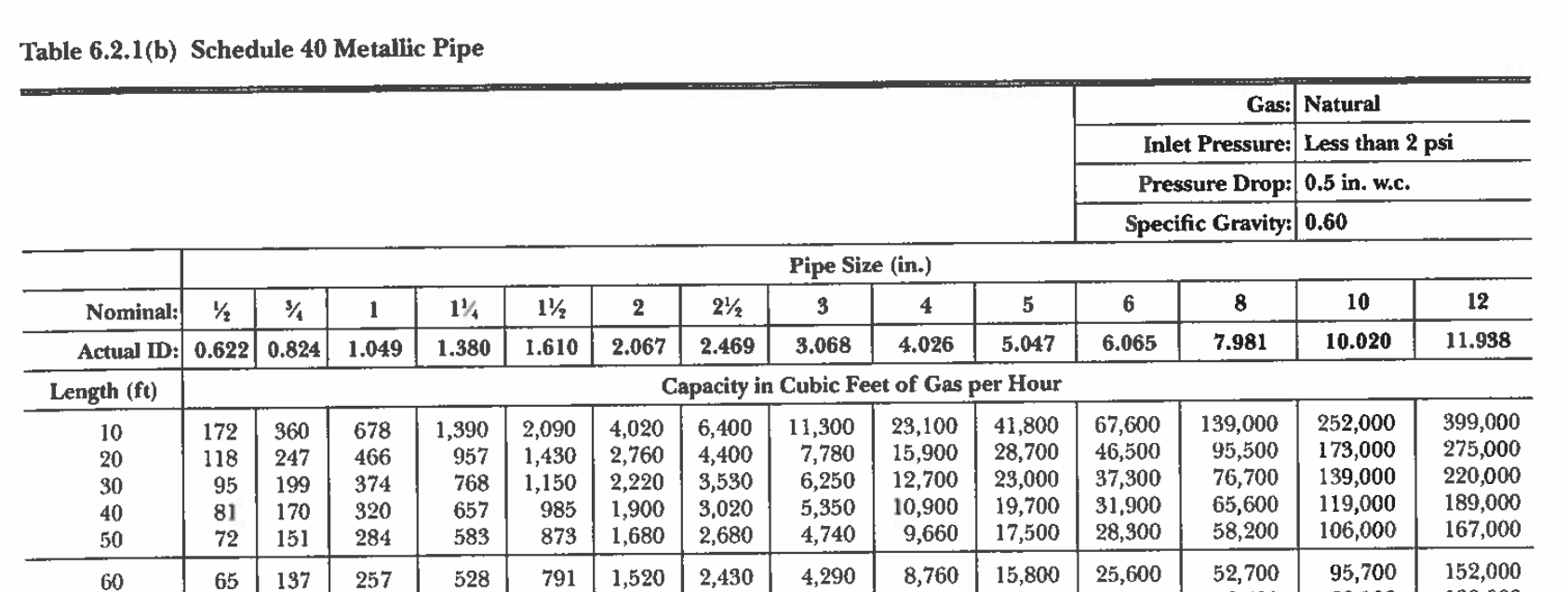Welcome! Here are the website rules, as well as some tips for using this forum.
Need to contact us? Visit https://heatinghelp.com/contact-us/.
Click here to Find a Contractor in your area.
If our community has helped you, please consider making a contribution to support this website. Thanks!
Understanding the NFGC Gas Sizing Tables
Options
cmaverick
Member Posts: 4
in Gas Heating
Hi all. Could somebody please let me know if my understanding of these tables is accurate for sizing natural gas piping.
Is the right way to read this like this....
If my 4,000MBH appliance requires an inlet pressure of less than 2psi, and I only want a pressure drop of 0.5in WC, and I have 10 feet of piping length I can use, then I need to use 2" or larger piping. Right?
So if i use a 2" line, and if my supply gas pressure from the meter is 6"WC, then my inlet pressure, in theory, should be 0.5" less than that at 5.5" right?

Is the right way to read this like this....
If my 4,000MBH appliance requires an inlet pressure of less than 2psi, and I only want a pressure drop of 0.5in WC, and I have 10 feet of piping length I can use, then I need to use 2" or larger piping. Right?
So if i use a 2" line, and if my supply gas pressure from the meter is 6"WC, then my inlet pressure, in theory, should be 0.5" less than that at 5.5" right?

0
Comments
-
That is a very large appliance
What are you hooking up?0 -
I've got two 3,000MBH gas-fired condensing boilers. The question though is more of a general question to make sure I'm understanding the appropriate way to read the tables.
As far as I'm understanding, it shouldn't matter whether I'm looking at the 0.5"WC pressure drop table, or the 3"WC pressure drop table, so long as I have sufficient volume and stay within the appliances minimum and maximum allowable range.0 -
As far as I know the 0.5 wc pressure drop is allowed.
Your sizing of the 2" pipe from 4000 cfh is right. I believe the code says your supposed to add for the fittings PD0 -
For a developed length of 10 feet, that's right. All the fittings used add to the developed length, i.e. a 90° adds IIRC 5 feet. So, if you're 10 feet away and have only one 90° fitting in the run you're at 15 feet already.
I'd look at 2½ minimum, but I get to deal with undersized gas piping all day long at work so I like to go strong, YMMV.
0 -
The appendix in the fuel gas code has instructions on how to use the charts. There are several methods listed.
We use the longest run method. Each section of pipe is sized in the column that equals the longest run of pipe. If your longest run is 50', every section is sized using the 50' column, whether the section is 1' or 49'.
,1 -
Categories
- All Categories
- 87.3K THE MAIN WALL
- 3.2K A-C, Heat Pumps & Refrigeration
- 61 Biomass
- 429 Carbon Monoxide Awareness
- 120 Chimneys & Flues
- 2.1K Domestic Hot Water
- 5.8K Gas Heating
- 115 Geothermal
- 167 Indoor-Air Quality
- 3.7K Oil Heating
- 77 Pipe Deterioration
- 1K Plumbing
- 6.5K Radiant Heating
- 395 Solar
- 15.7K Strictly Steam
- 3.4K Thermostats and Controls
- 56 Water Quality
- 51 Industry Classes
- 50 Job Opportunities
- 18 Recall Announcements
